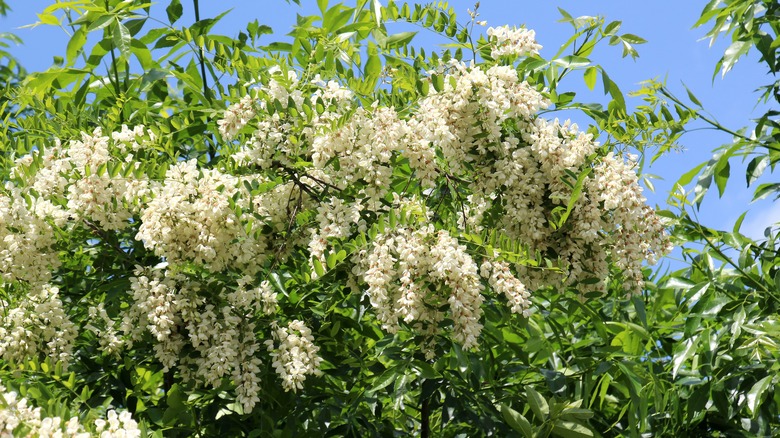The Black Locust tree is indeed a beautiful tree, but are the problems worth the beauty? Interestingly enough, while this tree is indeed native to North America, it is considered invasive outside of its historic native range. This is mostly because it has an aggressive growing habit and can easily take over natural areas. While some label it invasive, others praise it for its many benefits in the landscape as a nitrogen fixer for timber and preventing erosion. One thing is certain: if you plant this tree, whether it’s in its historic native range or not, it needs to be managed. This is not a tree you can plant and leave to its own devices, as it will completely take over the surrounding area. Plus, the branches are covered in thorns, so you do not want it to form a dense thicket unless you use it as a living fence. In that case, this quality comes in handy. The number one mistake people make when planting garden trees is not considering the tree’s growth habit and the surrounding area. When it comes to the black locust, you definitely want to do your research into this tree and figure out if and where you want to incorporate this tree into your yard.
What is the Black Locust tree?

A member of the Fabaceae family, the Black Locust is a leguminous, nitrogen-fixing tree originally native to the Appalachian mountains. It can reach heights of 100ft with reddish brown to black bark. The branches are covered in thorns occurring at each node, and in the spring, the tree emerges with a striking display of white, fragrant flowers. The flowers are edible and taste like a sweet candied pea. However, it’s important to note that the rest of the tree is toxic for humans, including the leaves. Additionally, the flowers are an important nectar and pollen source for native bees, honeybees, hummingbirds, and other pollinators.
The Black Locust timber is one of the strongest native to North America. The wood is hardy, rot-resistant, and incredibly durable. It was brought from the Appalachian mountain range to the West Coast of the US during the Gold Rush by pioneers who grew it for timber. Since then, it has completely escaped its native range and naturalized throughout the US and even in parts of Europe and Asia. However, it is important to distinguish between invasive plants and aggressive growers. Aggressive growers often include native plants and refer to the plant’s intense growth habit and ability to take over a landscape without intervention. Invasive plants both take over an area and do not support the native ecosystem in any capacity. While aggressive native plants may choke out other native vegetation, they also support the local ecosystem in other ways.
Pros and cons of growing the Black Locust tree
As we already established, the Black Locust tree is widely considered invasive. It’s a very hardy and competitive plant, and it spreads by root suckers and rhizomes, as well as by seed, so it can quickly take over an area if not managed properly. In addition to its aggressive growing habit, it proliferates quickly, allowing it to form dense clusters that out-compete native vegetation. It poses threats to different kinds of native habitats, from oaklands to savannahs, due to its preference for dry, well-draining soil and its aggressive suckering growth habit that chokes out other native vegetation.
However, in the farm landscape, there are a plethora of benefits that the Black Locust has to offer. One of the benefits of Black Locusts is that it’s fast-growing, fixes nitrogen into the soil, thereby building healthy soil, and creates an excellent windbreak, living fence, or shelter for livestock in a matter of months. The rot-resistant wood is a great option for fence posts, outdoor furniture, decks, and other weatherproof wood projects. Additionally, due to its ability to build soil and fix nitrogen, it is used in reforestation projects and for stopping erosion. While the Black Locust can be invasive in certain settings, it is a highly beneficial tree in well-managed landscapes. It is not recommended in residential areas as it has thorns and can aggressively take over gardens and surrounding areas. However, it’s an excellent ally if you can commit to managing it.